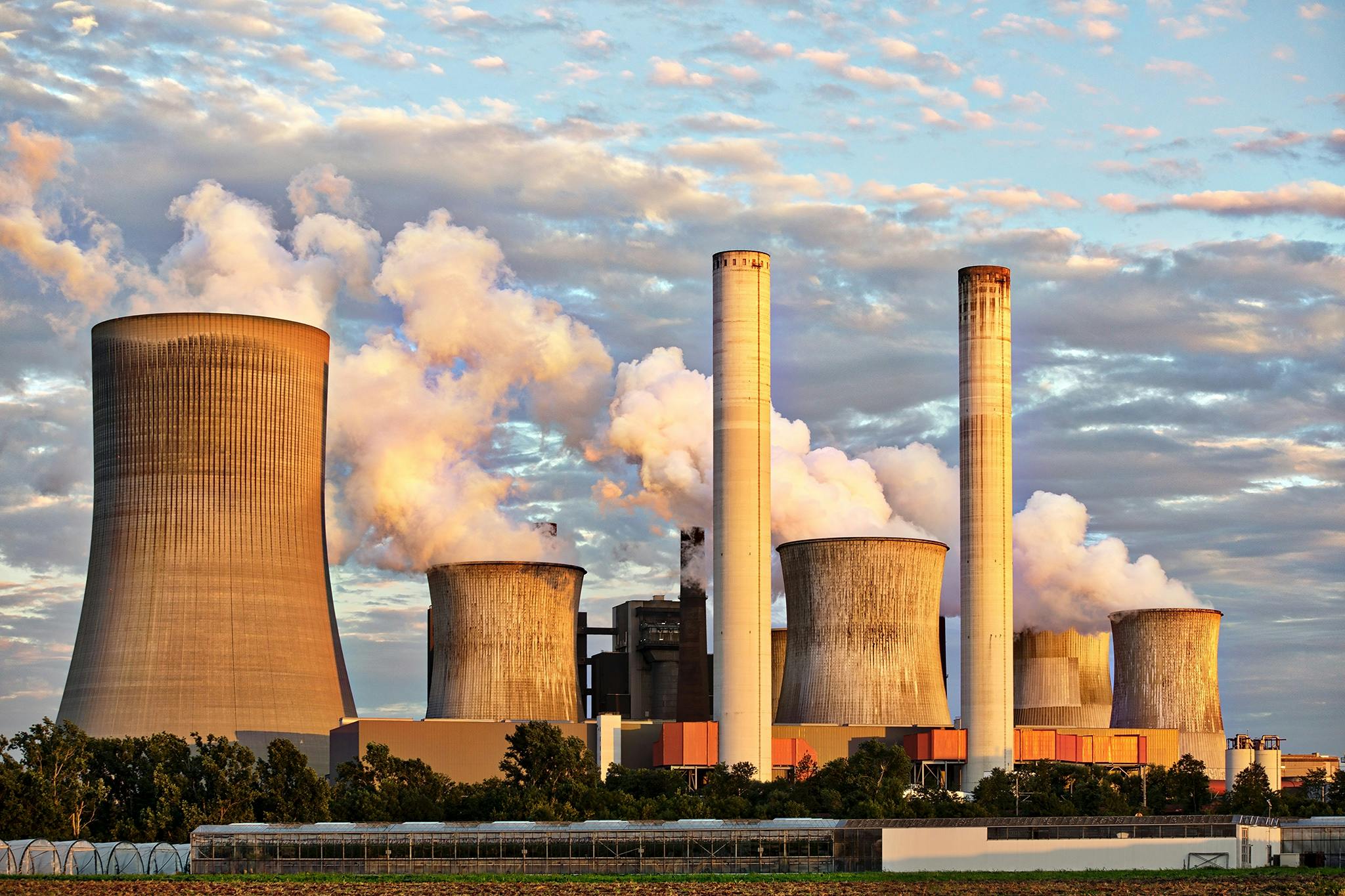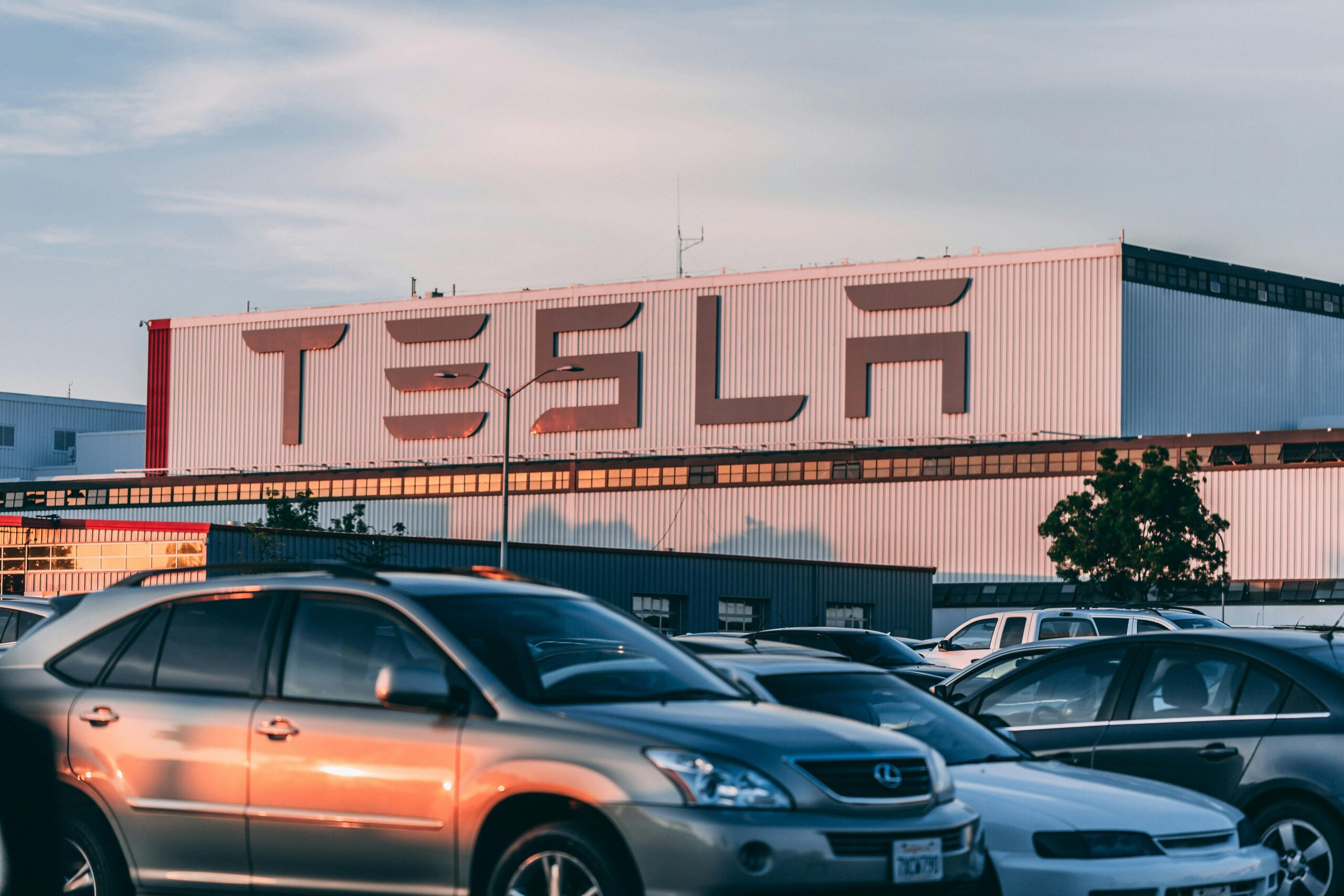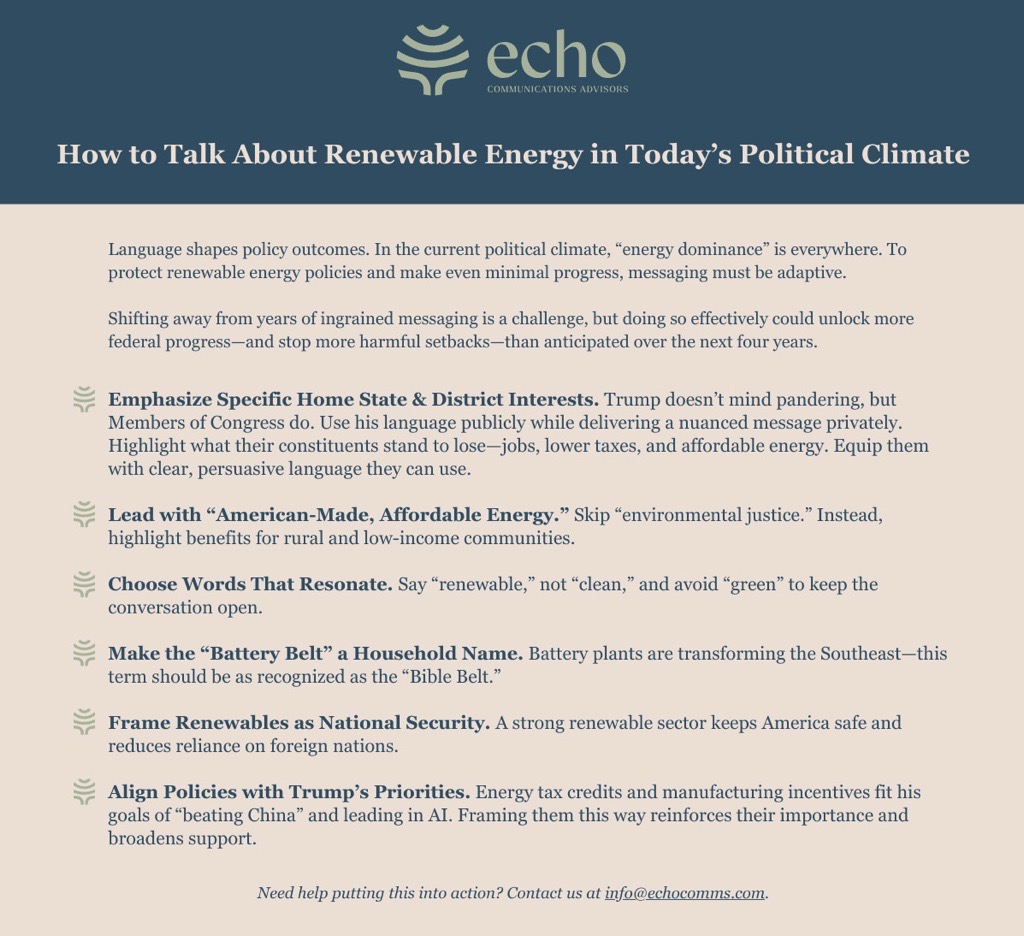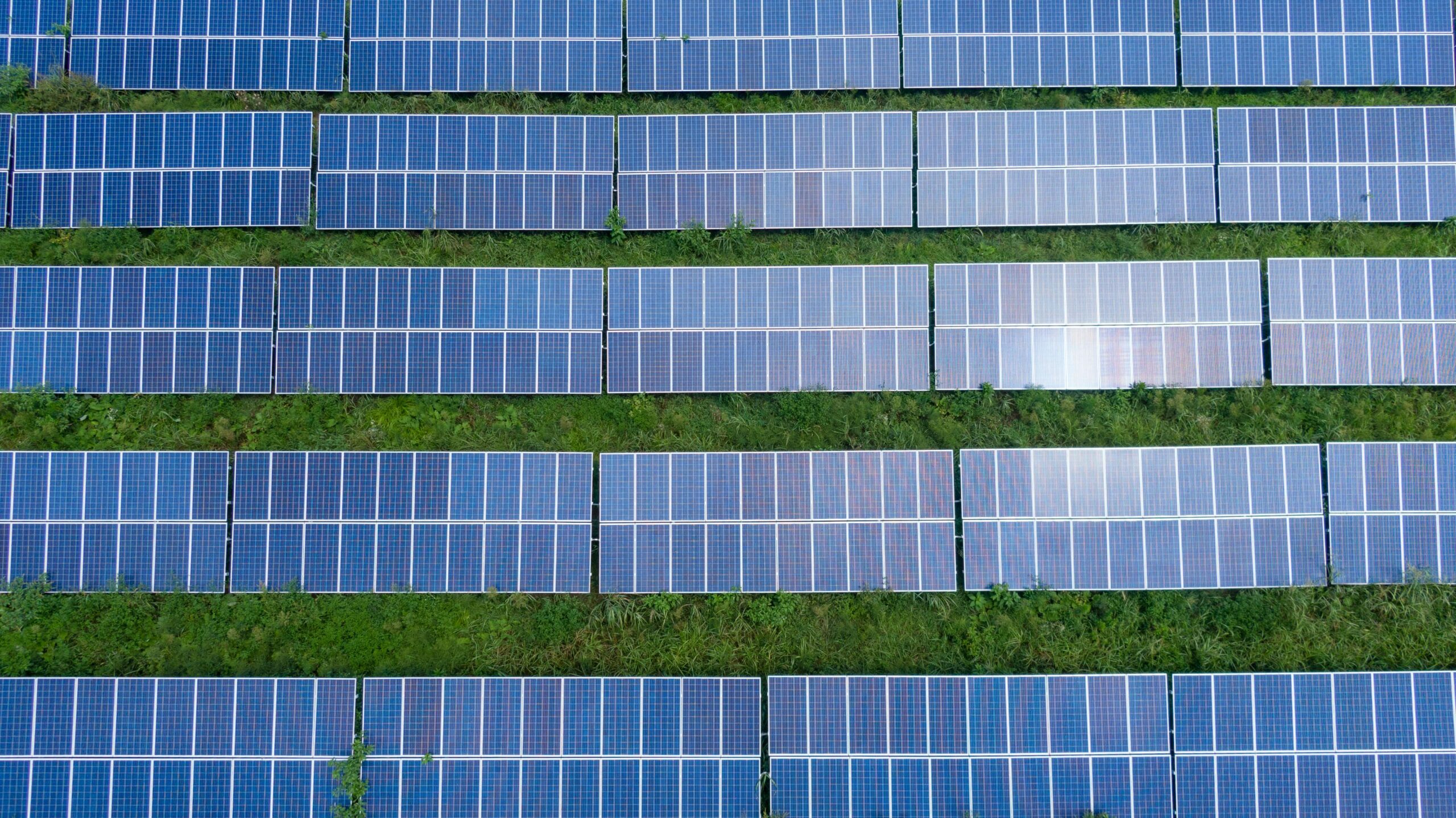
Chris Moyer
Founder & President
“Energy dominance” is suddenly everywhere. Here are a few recent examples:
- “As we look forward to building greater American energy dominance, the solar and storage industries stand at the ready to further expand clean, reliable domestic energy production,” wrote hundreds of companies in a February 5 letter to Congress, led by the Solar Energy Industries Association.
- “Transmission is the key to American energy dominance,” is the headline of a January 29 op-ed by Christina Hayes, executive director of Americans for a Clean Energy Grid.
- “We stand ready to work with you to implement President Trump’s bold energy dominance agenda,” wrote hydrogen industry companies and advocates in a Feb. 18 letter to Congress, making the case for keeping the clean hydrogen production tax credit in place.
We all know why.
The clean energy community is adapting to the political reality ushered in on January 20. Adopting President Trump’s preferred language is the best chance of shielding the clean energy sector from harm, sustaining a growing renewable energy economy, and advancing technologies like geothermal, carbon capture, and hydrogen. It’s the right strategic choice, even if it’s a jarring pivot.
What “Energy Dominance” Means to Trump
For Trump, “energy dominance” doesn’t mean an all-of-the-above strategy.
His definition is entirely fossil fuel-driven:
- Maximize fossil fuel production—not just for domestic use, but for global exports.
- Expand natural gas exports aggressively.
- Drill for oil anywhere and everywhere, even if oil executives don’t want it.
- Suppress EV growth to maintain demand for oil and gas.
- Secure critical minerals, not by boosting domestic supply chains but by buying Greenland and coercing Ukraine.
- Deregulate methane emissions, letting natural gas producers leak at will.

This is Trump’s baseline view of energy policy. By co-opting his language, clean energy advocates are trying to expand that definition—to broaden his perspective beyond fossil fuels alone.
The argument is simple: It doesn’t matter that Biden’s administration passed clean energy incentives through the Inflation Reduction Act (IRA) and the Infrastructure Investment and Jobs Act (IIJA)—those incentives should be preserved anyway. Hydrogen can be “dominant.” Carbon capture and removal and geothermal have oil industry backing (from the same companies that funded Trump’s campaign). Solar is an American-made energy source that strengthens U.S. energy independence.
The goal? Redefine “energy dominance” to include renewables—by framing them in terms that align with Trump’s worldview and agenda.
Trump’s Challenge: Energy Supply vs. AI & Manufacturing Growth
Trump needs renewables, whether he realizes it or not. The U.S. simply lacks the energy capacity to support his broader economic priorities without them.
Trump wants the U.S. to lead the world in AI, but AI data centers require enormous amounts of power. Without a massive energy expansion, his own energy policies will undermine that goal. Cryptocurrency mining, though less of a focus, also requires substantial energy.
He wants to revitalize U.S. manufacturing, but such industrial growth demands low-cost, reliable energy. And there are a lot of growth opportunities for clean tech manufacturing.
He wants to “beat China” at everything, yet China is winning the EV race. China’s BYD is surging ahead in producing and selling affordable EVs. Now is the worst possible time to repeal the incentives accelerating EV growth—the very policies that could keep the U.S. competitive in this market.

Reasons for Optimism?
Two of Trump’s least controversial cabinet appointees could help expand his energy perspective: Secretary of Energy Chris Wright is a staunch advocate for oil and gas, but he recognizes the value of geothermal and some renewables. Secretary of the Interior Doug Burgum, also the chair of the National Energy Dominance Council, hails from North Dakota, where nearly 40% of the state’s electricity comes from wind. He understands its economic benefits.
Both Wright and Burgum have the opportunity to influence, even if it’s ever so slightly, Trump’s approach to energy policy.
Yet such optimism is tempered by comments like those Wright made on Monday: “Net zero 2050 is a sinister goal, it’s a terrible goal…This is not energy transition, this is lunacy.”
The effort to align with this administration has its limits—outright denying the reality of the energy transition is not a viable strategy.
Messaging in This New Political Landscape
How should renewable energy advocates and executives communicate in this new reality? And not just to Trump and his inner circle, but to Republican members of Congress, who still wield significant power as a co-equal branch of government. Here’s how:
- Emphasize Specific Home State & District Interests. Trump doesn’t mind blatant pandering, but Members of Congress often see through it. Use Trump’s “energy dominance” language publicly while delivering a more nuanced message privately to legislators and staff. Highlight what their constituents stand to lose—jobs, lower taxes, and reduced energy bills. Equip them with compelling, adoptable language they can use in their own communications.
- Lead with “American-Made, Affordable Energy.” Avoid “environmental justice”; instead, highlight benefits for rural communities and low-income Americans. This framing is more inclusive and aligns with Trump’s base.
- Choose Language that Connects. Use “renewable” instead of “clean”, and steer clear of “green” altogether—these terms have become politically loaded and can shut down the conversation before it even begins. Our focus must be on the outcome, not rigidly clinging to how we get there.
- Make the “Battery Belt” As Widely Recognized As the “Bible Belt.” With battery plants transforming the Southeast, this term needs to become a household name—helping to build support for pro-climate and renewable energy policies.
- Emphasize the National Security Angle. “A strong renewable energy sector—including critical minerals and supply chain production—keeps America safe.” It also reduces our dependence on foreign nations, some of which may not have our best interests at heart.
- Align Policies with Trump’s Priorities. Supporting energy tax credits and manufacturing incentives directly ties into Trump’s goals of “beating China” and leading the world in AI. Framing these policies in that context reinforces their importance and positions them as essential to achieving objectives that often garner bipartisan support.
Language shapes policy outcomes. Today, “energy dominance” is the phrase du jour. To protect clean energy policies and make even minimal progress, messaging must be adaptive.
Trump favors fossil fuels—but his economic ambitions require a broader energy approach. Clean energy advocates must frame tax credits and other policies as essential to achieving Trump’s biggest goals: U.S. leadership in AI; rebuilding American manufacturing; and competing with (and beating) China.
Shifting away from years of ingrained messaging is a challenge, but doing so effectively could unlock more federal progress—and stop more harmful setbacks—than anticipated over the next four years.

Sign up for our newsletter
Receive updates on our work, industry news, and more.

